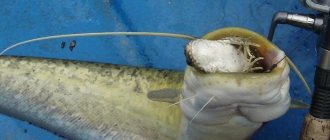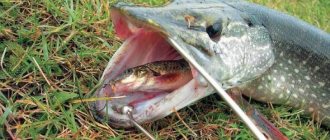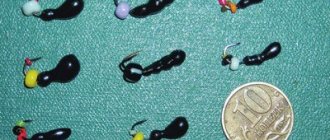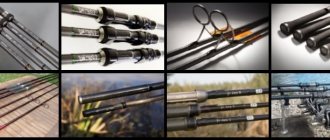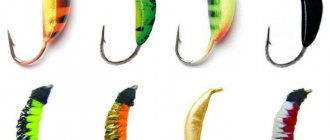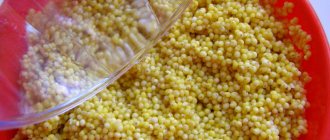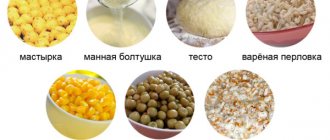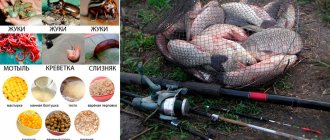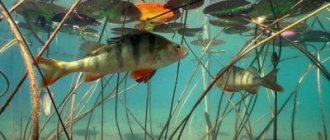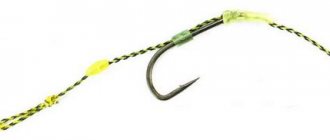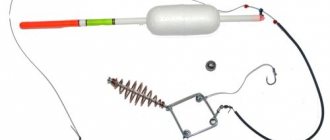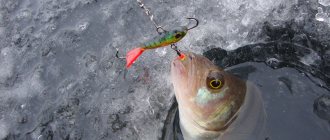The cold Siberian rivers are famous for their huge fish stocks, and their inhabitants for their excellent gastronomic qualities. The salmon family alone contains many freshwater and anadromous (freshwater-spawning) species that are a real delicacy. Who doesn't love salmon, pink salmon or trout? This also includes muksun fish - northern whitefish, which has become the number one goal for fishermen due to its tender, tasty meat of moderate fat content and a small number of bones.
Unfortunately, today muksun is on the verge of extinction, because it is caught not only by fishermen and supporters of sport fishing methods, but also by malicious poachers. Every year there are fewer and fewer of these fish, but this only increases the fishing excitement. Catching a decent-sized muksun brings great pleasure, increases self-confidence and self-esteem, and arouses the envy of colleagues. Another reward for your efforts will be a delicious dish of this delicious northern fish.
Muksun – description with photo
Muksun fish is a cold-loving fish, found mainly in taiga rivers and lakes. It inhabits a vast territory from the Kara River (Yamalo-Nenets Autonomous Okrug) to the Kalyma River (Yakutia).
Numerous populations live in the basins of the Irtysh, Lena, Ob, Yenisei, and in Lake Taimyr. This is a semi-anadromous species that rushes to spawning grounds after the ice melts, but reaches them only in the fall. The spawning season lasts from September, when northern bodies of water are already beginning to become covered with an ice crust, until a sharp drop in water temperature in November. It is interesting that females of this species do not lay eggs annually; the process of procreation occurs once every 5 years. The number of eggs laid can reach 60,000 pieces. The fry hatch in the spring and immediately move to the lower reaches of the river.
Compared to some other species that live in the region’s water bodies (taimen, nelma), the size of the muksun is not particularly impressive. The largest specimen caught weighed about 13 kg, and its length did not reach even a meter. Nowadays, even a 2-kilogram individual is caught quite rarely; mostly young muksuns weighing from 0.5 to 1.5 kg are caught.
This type is distinguished by the following external characteristics and exterior features:
elongated head with a large upper jaw and a mouth located in the lower part;- slightly raised tail;
- there is an adipose fin;
- in adults there is a distinct hump on the back;
- body color: dark blue back, silver sides, light belly;
- The size of the scales is average, in one lateral line there can be up to 110 pieces;
- The scales are weak and can be easily peeled off with a knife.
The muksun has no biological subspecies; there are anadromous forms that differ in color and timing of puberty. As a rule, these are local populations that have settled in a particular territorial zone.
Muksun in the lakes of Russia. Fishing and methods of catching muksun
Muksun is a valuable commercial fish of Siberia. Belongs to the whitefish family. Found in large northern rivers: Ob, Irtysh, Yenisei, Lena. The fish is quite large: more than half a meter long, weighing up to 8 kg. Some specimens reach 13 kg. The usual weight of muksun is 1-2 kg. Larger specimens (3-4 kg) are easily exchanged by local residents for a pound-sized nelma. In appearance, muksun differs from nelma. The body is elongated, laterally compressed, and rises steeply behind the head. The color is dark on the back, silver on the sides, light white on the belly. Muksun is a semi-anadromous fish, that is, it constantly migrates for spawning. From the desalinated coastal waters of the Arctic Ocean, where it feeds, it goes upstream of the Siberian rivers to spawn. Treat tributaries with caution and do not climb high along them. For example, on the Tom River, spawning pits are found at the mouth of the river and slightly upstream. Although a hundred years ago the muksun spawned much higher, and its quantity in Tom was such that the local residents were called “muksunniks”. Muksun is found in the Ob River, but does not enter tributaries, even such large ones as Ket or Chulym. You can only catch him there by chance. The muksun's diet varies depending on the season: in summer - mollusks and benthic crustaceans, in winter - zooplankton. In the sea, the main diet consists of amphipods, mysids and sea cockroaches. Immediately after the ice breaks up, the muksun begins its spawning run. It reaches the place only in the fall: in September - early October. It begins to spawn in October - November, during the formation of ice cover on the rivers, at a temperature of - 4 C°. The predominant place for spawning is riffles with flagstone and pebble bottoms. In many northern regions, it is prohibited to catch muksun. Where fishing is permitted, fishing fixed or floating nets are most often used. The method of fishing with flies is also used. You need to make a lot of them, since the fish feeds on a wide variety of underwater insects. It is not known what the muksun will like. It happens that a bright fly, red, burgundy or orange, attracts the muksun much more than one whose appearance resembles the insects that the muksun usually eats. So experienced fishermen have to create real masterpieces: make bait copies of insects and crustaceans or decorate midges with colored plumage. There is no guarantee that the muksun will like it this time. The whims of the muksun are sometimes amazing. It happens that fish do not react to live midges, preferring artificial bait. Less experienced fishermen believe that there is a special secret to making such flies. But experienced fishermen are sure that real masters are able to make the bait perfectly similar to a living insect.
Nutritional Features
This fish is in constant motion, which is explained by the need to get food. The objects of search for muksun are microorganisms living in the bottom soil, various aquatic insects, larvae, mollusks, leeches, and small crustaceans.
The diet of the young consists mostly of zooplankton and eggs of other representatives of the salmon family. Adults will not miss the opportunity to feast on the gaping fry of their closest relatives. After spawning, they become omnivores, because they need to restore their strength.
The mass emergence of semi-aquatic insects is a long-awaited phenomenon for muksun. He begins to literally feast, every now and then rising to the surface for the next victim. May beetles, ground beetles, chironomids, honeydews, fireflies, night moths and other insects fall on the water. During this period, he always has something to profit from; he just needs to rise to the upper layers.
Secrets of catching muksun
Commercial fishing for this fish begins in winter, immediately after it spawns. It must be said that when using nets, catches are calculated in tons, but fishing on such a scale is allowed only in certain regions of Siberia and requires a special license. Sport fishing is prohibited only in certain areas; in all others you can fish. Many amateur fishermen are willing to stay up at night to catch this tasty representative of the Siberian ichthyofauna.
How to catch muksun? Before talking about fishing gear and catchable baits, it’s worth figuring out where it can be found. According to Siberians, this fish is caught well on the Yenisei and some of its tributaries, the Irtysh and Lena. Until recently, the same thing was said about the Ob, but due to unauthorized fishing, the muksun population in this river has noticeably decreased.
So, if a reservoir has been selected, all that remains is to arm yourself with basic knowledge about the sites of the fishing object. Where on the river can fish linger? Experienced fishermen identify several promising areas where muksun fish live:
- Near shallows, spits and rifts. In such places they begin to fish several days before the expected spawning and after its end. Muksun spawns on riffles with a pebble or sandy bottom, so there is always a chance that several individuals will come here ahead of time or linger after spawning to regain strength before the long journey back to their usual habitats.
- On the bends of the main channel. As you know, deep holes form at river bends, over which the fish likes to stay above. At the same time, it can stand at half-water or closer to the surface. It’s worth taking a ride around the pond in advance on a boat with an echo sounder and noticing promising areas so you can fish for them later. If you are lucky enough to find a school of feeding muksun, exciting and productive fishing is guaranteed.
- At the confluence of tributaries. Flowing rivers, canals and streams carry a lot of food and maintain oxygen levels, so such areas are usually full of different fish. Muksun is no exception. He, too, will not miss the opportunity to profit from a crustacean or some other living creature that has fallen into a whirlpool formed as a result of the merger of two different currents.
The most reliable way to find muksun is to communicate with local fishermen. They will always tell you where to catch this Siberian beauty. At the same time, it is worth asking about the prohibitions in the selected area; it is quite possible that fishing for muksun is prohibited here.
In amateur fishing, two methods of catching muksun are used - spinning tackle and fly fishing. By and large, the choice of tool is not of great importance; the competent selection of bait is much more important, because this fish is known for its whimsicality and capriciousness. Her preferences constantly change depending on the time of day, weather conditions and other reasons that even fishermen with extensive experience cannot explain. If the bait worked well in the morning, it may no longer be effective in the evening.
Lifestyle
Malek
The malek is distinguished by its brindle coloration. Immediately after birth, the fish rushes into coastal plants, where it begins actively feeding on plankton and benthic organisms. The fry, having grown to 3-5 cm in length, roll down into a stagnant body of water.
Lifestyle, behavior
Muksun is distinguished by endurance and perseverance. The fish spends a lot of time and effort on the spawning run, saving strength to return back. Adults travel up to 2 thousand km upstream when going to spawn. Enhanced nutrition allows you to quickly regain weight and strength. To search for food, the muksun fish chooses flowing areas with cool water 3-5 m deep. The individual lives in places that must meet the following requirements:
- constant temperature;
- underwater shelters;
- water with oxygen.
Habitat
Muksun lives in clean freshwater bodies of water; the water may be slightly brackish. It is not found in the ocean. This species prefers river mouths, where fresh and salt waters mix. Large populations can be found in the waters of the Lena, Yenisei, lakes Lama, Taimyr and Glubokoe. Individuals live in almost all Siberian rivers, as well as in the Arctic Ocean. Large populations are present in the Tom and Ob rivers, where fish are present year-round.
Diet
The diet depends on the living conditions, time of year, and food supply. In summer, muksun fish feed on crustaceans and mollusks, and in winter they switch to plankton. The fry mainly feed on plankton, since they cannot hunt for other prey and digest it. The structure of the gills allows for complete feeding.
Most of the diet consists of crustaceans, caviar, fry, and plankton. During the spawning period, the volume of food consumed decreases. Satisfying primary needs allows one to avoid death. During the breeding season, all the efforts of the individual are aimed at finding the way to the spawning grounds. The fish must find places to spawn before the first ice appears.
Reproduction and offspring
The lifespan of fish reaches 20 years, because of this, puberty occurs quite late. On average, muksun fish go to spawn after reaching the age of 8-12 years. The minimum age is 6-7 years. This feature is considered one of the reasons for the population decline due to uncontrolled fishing.
Spawning
The first wave of spawning occurs from July to August. The process is accompanied by a mass exodus of the population to river mouths, from where it goes to search for places to spawn. Later, a second wave of river inhabitants that did not feed in the sea goes to spawn.
The optimal temperature for spawning is considered to be from +4 to +8 degrees. At high temperatures and warm autumn, the fish begin to actively feed, which allows them to wait out the winter. Muksun spawns in portions, with significant time gaps between them. Sometimes the process can drag on throughout the fall and even winter. After spawning is completed, the family returns to its permanent habitat.
For spawning, muksun chooses shallow areas with running water. The bottom is covered with pebbles, small stones, and sand. The female lays 25-40 thousand eggs at a time. Caviar quickly sticks to hard surfaces due to its sticky surface. The incubation period lasts 180-200 days. The fry appear in late March - early May.
Natural enemies
In nature, muksun has enemies, but they do not pose a danger. Most often these are larger predatory inhabitants of the aquatic depths. They pose a danger to fry and eggs, which actively eat other fish.
The main enemy is man and uncontrolled fishing. Muksun going to spawn are in great danger, which is taken advantage of by poachers. Human activity has led to the pollution of water bodies and a significant decrease in the population of muksun and other fish species.
Commercial value
The uniqueness of muksun lies in the composition of the meat, which belongs to the category of delicacies. Regardless of the degree of freezing, the meat does not lose its unique, incomparable aroma, reminiscent of the smell of freshly cut cucumbers. A kilogram of fish will cost 700 rubles. Muksun has been bred in nurseries for commercial purposes for a relatively long time.
The fish is resistant to parasites, so raw meat can be used for food. It should be borne in mind that heat treatment increases the safety of meat consumption, as does freezing.
Nutritional value
Muksun retains its taste properties even when severely frozen. The energy value of the product is 89 kilocalories per 100 g. The meat is completely digestible. Arachidonic acid provides additional energy to people experiencing regular increased stress. Fish is recommended for consumption when it is necessary to restore the body.
The composition of muksun is almost similar to the meat of different types of marine fish. It does not contain many minerals, which makes it possible to eat meat if you have kidney problems. Fat is not harmful because it does not lead to the formation of vascular plaques. Fish oil is highly absorbable.
Useful properties of the product:
- increasing protective forces;
- stimulation of the cardiovascular system, hematopoietic system;
- activation of the central nervous system,
- increased brain activity;
- activation of metabolic processes;
- increasing endurance during exercise.
Population and species status
Muksun belongs to the category of commercial fish. Uncontrolled fishing and poaching have led to a significant reduction in the population. The issue of including this species in the Red Book is currently under consideration. Security measures are already being carried out, which is having a certain effect. The muksun fishery has been brought under control. Since 2014, restrictions on fishing have been introduced in some regions.
Muksun is actively bred in artificial conditions, from where the fish is supplied to stores.
